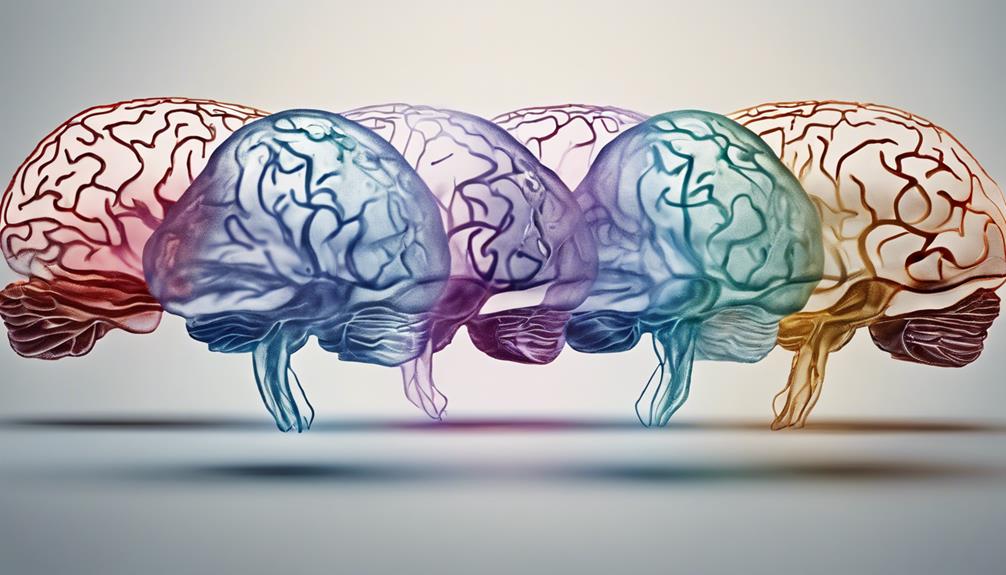Were you aware that approximately 2-3% of people with diabetes may encounter double vision? Recognizing the connection between diabetes and double vision can offer helpful insights on how to address this troubling symptom.
The impact of diabetes on the eyes goes beyond just vision problems, and delving deeper into this topic can reveal important insights into overall diabetes management.
Key Takeaways
- Diabetic Retinopathy can lead to eye muscle paralysis causing double vision.
- Regular eye exams crucial for early detection and management of double vision.
- Prisms and surgery options available for addressing diabetes-induced double vision.
- Maintaining stable blood sugar levels essential in preventing diabetes-related double vision.
Causes of Diabetes Double Vision
Diabetes-induced damage to circulation can lead to paralysis of the eye muscles, causing double vision. This complication, known as Diabetic Retinopathy, results from prolonged high blood sugar levels affecting the small blood vessels in the retina. The eye muscles responsible for coordinating eye movements can become weakened due to diabetes-induced damage, leading to difficulties focusing both eyes on the same object. The intricate connection between the nervous system and the eye muscles can be disrupted by diabetes-related nerve damage, resulting in misalignment and double vision.
To diagnose the specific cause of double vision in diabetic individuals, healthcare professionals may recommend various diagnostic tests. These tests aim to pinpoint the exact cranial nerve involvement contributing to the visual disturbances. It's crucial to differentiate between benign muscle palsy from diabetes and more serious underlying conditions like tumors or aneurysms that could also present with double vision symptoms. By understanding the causes of diabetes-induced double vision, appropriate interventions can be implemented to address these specific issues effectively.
Symptoms of Diabetes Double Vision

When experiencing symptoms of double vision related to diabetes, individuals may notice the sensation of seeing two images when focusing on a single object. This condition can be distressing and impact daily activities, emphasizing the importance of managing blood sugar levels effectively. Here are key symptoms to be aware of:
- Eye Misalignment: Diabetic double vision often presents with a misalignment of the eyes, leading to the perception of two distinct images instead of one.
- Overlapping Images: High blood sugar levels in diabetes can contribute to overlapping images, making it challenging to see clearly and causing visual discomfort.
- Eye Muscle Coordination: Nerve damage from uncontrolled diabetes can affect the coordination of eye muscles, resulting in the manifestation of double vision.
Recognizing these symptoms and seeking timely medical attention, including regular eye exams, can aid in the early detection of conditions like Diabetic Retinopathy, mitigating the risk of complications and ensuring optimal eye health.
Diagnosis of Diabetes Double Vision
To pinpoint the root cause of double vision in individuals with diabetes, a comprehensive eye examination conducted by either an optometrist or ophthalmologist is imperative. During the diagnosis process, healthcare providers focus on assessing nerve palsies, muscle weakness, and eye alignment issues.
Specialized tests like eye movement evaluation, pupil response assessment, and cranial nerve function tests are often performed to identify the specific factors contributing to double vision. In diabetic individuals, the examination may also involve evaluating the impact of blood glucose levels, diabetes medicine, and the risk for Diabetic Retinopathy on eye health.
Determining which cranial nerve is affected, such as the third or sixth nerve, is crucial for devising an appropriate treatment plan. Timely diagnosis plays a vital role in intervention and management outcomes, highlighting the importance of a thorough and detailed assessment to address the complexities of diabetes-induced double vision.
Treatment Options for Diabetes Double Vision

Treatment options for double vision caused by diabetes may vary depending on the severity of the condition and individual needs. When addressing this issue, it's crucial to consider the impact of high blood sugar on the eyes, specifically in diabetic retinopathy, which can lead to vision problems like double vision. Here are some key treatment options to manage diabetes-induced double vision:
- Prisms: Prisms can be used to help adjust the alignment of the eyes and reduce double vision symptoms by altering how light enters the eyes.
- Eye Muscle Palsies: Improvement in eye muscle palsies causing double vision often occurs gradually over time, and long-term use of prisms in glasses may be necessary to manage residual diplopia effectively.
- Eye Muscle Surgery: In severe cases of residual diplopia from diabetes, eye muscle surgery may be required for resolution, especially when other treatments are ineffective.
Close monitoring of blood glucose levels and regular eye examinations are essential in managing diabetic-induced double vision.
Prevention Strategies for Diabetes Double Vision
In managing the impact of high blood sugar on the eyes, particularly in diabetic retinopathy, prevention strategies for diabetes-induced double vision are crucial for maintaining optimal vision health. Maintaining stable blood sugar levels is key to preventing diabetes-induced double vision.
Regular eye check-ups play a vital role in detecting early signs of eye muscle paralysis, helping prevent double vision. Effective management of diabetes, including proper medication adherence, significantly reduces the risk of double vision.
Monitoring and controlling blood glucose levels are essential in preventing diabetes-induced double vision. Proper eye care, such as regular examinations and prompt treatment, is crucial in preventing and managing double vision in diabetic patients.
Frequently Asked Questions
What Are the Signs That Diabetes Is Affecting Your Eyes?
When diabetes affects your eyes, signs may include:
- Blurred vision
- Floaters
- Dark spots
- Sudden changes
- Trouble focusing
- Eye pain
- Halos around lights
- Double vision
- Difficulty reading
- Gradual vision loss
- Distortion
- Prescription changes
Regular eye exams are crucial to detect diabetes-related eye issues early and prevent vision loss. It's important to pay attention to these symptoms and seek prompt medical attention for proper management of diabetic eye complications.
Is Double Vision a Symptom of Low Blood Sugar?
Yes, double vision isn't typically a symptom of low blood sugar. It's more commonly associated with complications of diabetes affecting the eye muscles.
Symptoms of low blood sugar often include shakiness, sweating, and confusion. Monitoring blood sugar levels and managing diabetes effectively can help prevent episodes of double vision.
Seeking prompt medical attention for persistent double vision is crucial to determine the underlying cause and appropriate treatment.
What Are 2 Symptom of Early Stage Diabetic Retinopathy?
Yes, early signs of diabetic retinopathy can include:
- Blurred vision upon waking
- Spotting floaters or dark spots in our field of vision
These symptoms may indicate the onset of this condition and should prompt a visit to an eye care professional for further evaluation.
Early detection can help in managing diabetic retinopathy effectively and preserving our vision in the long run.
What Does a Diabetic Eye Look Like?
A diabetic eye may exhibit signs such as retinopathy, macular edema, neovascularization, exudates, and ischemia.
These manifestations include tiny hemorrhages, swelling in the macula, abnormal blood vessel growth, yellowish deposits, and compromised blood supply to the retina.
These characteristics are indicative of diabetic eye complications and require careful monitoring and management to prevent further damage and preserve vision.
Conclusion
In managing diabetes double vision, it's crucial to prioritize:
- Blood sugar control
- Medication adherence
- Regular eye monitoring
By staying proactive and vigilant in our approach, we can navigate through the challenges of this condition with clarity and focus.
Remember, in the journey of managing diabetes double vision, we must keep our eyes on the prize to ensure a clear path ahead.









